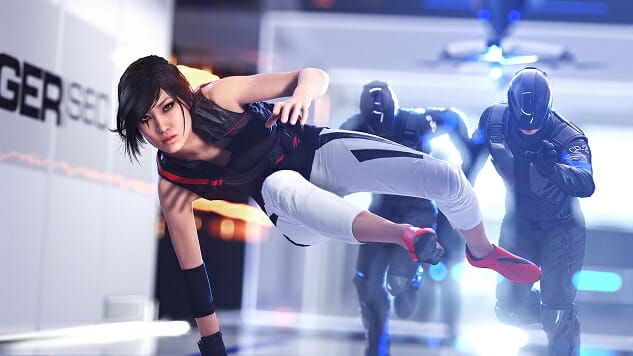Mirror’s Edge: Catalyst Forgets What Made Mirror’s Edge So Great

Mirror’s Edge is a modern classic, one of the best games of its (or any other) era, and as much of an anomaly today as it was when it was released in 2008. With its emphasis on movement over combat and its sleek, futuristic cityscape, it doesn’t look, feel or play like any other big budget first-person game. It’s focused almost exclusively on forward motion, as you sprint through the city and pinball off walls and ledges while avoiding contact with violent security forces as much as possible. You can fight back, poorly, but the game never forces you to, always leaving open an escape route, even if you may not always be able to see it at first or enter the complicated button pattern required to exploit it. It rarely slows down, shuttling the player from level to level, each one offering a different perspective on the dystopian city where citizens are constantly under surveillance. The intentionally slim story is similarly rushed through, relayed through brief animated cut-scenes before and after every level. There are almost no wasted moments, and few distractions from the core tenets of running fast and climbing hard. The game is as elegantly designed as the city it’s set in, and it’s as fresh and exhilarating today as it was in 2008.
Mirror’s Edge wasn’t a hit, dividing both critics and consumers. The new reboot, Mirror’s Edge: Catalyst, recaptures some of what makes the original so great, with our hero Faith gracefully vaulting over obstacles, running along walls and tumbling from rooftop to rooftop. It also stumbles too often, with questionable choices that feel like misguided attempts to fix what wasn’t broken. By listening to their critics and trying to address some of the more common complaints about the original game, Catalyst’s designers have sacrificed some of the first Edge’s unique spirit. It’s not a catastrophe, and it still possesses a fair amount of the original’s spark, but it’s a diminished version of what came before.
There’s no overarching, crucial mistake here, but a series of bad calls that add up over time. Turning it into an open world game might have been the biggest misstep. With objectives, collectibles and side-missions all over the map, there are distractions everywhere that have to be tuned out. You’ll be running from a chopper or drone, or trying to complete a run within a tight time limit, and see a graphic pop up on the edge of the screen about an optional security chip that can be collected. This structure also leads to rampant backtracking, and although that works brilliantly in the Metroid games, it runs counter to the momentum at the heart of Mirror’s Edge. You’ll rerun the same stretches so often that running will lose its thrill. You can eventually fast travel to safe houses to cut out some of the repetition, but fast travel is antithetical to what Mirror’s Edge stands for.
In keeping with the game’s new open world structure, Faith also now has a skill tree. Certain abilities that are absolutely necessary and were available from the start in the first game are now locked up until you’ve earned enough experience. This includes the rapid 180 degree turn and the trick where Faith coils her body in mid-air to make herself more aerodynamic. It’s not hard to earn skill points and unlock these abilities, but it feels like busy work, like an unnecessary level of videogame business added because people expect it from games that are structured like this one. Similarly, Catalyst also introduces its version of a grappling hook, another open world staple, and one which defeats the purpose of a game built around a version of parkour that’s more physical and precise than the real thing.
Catalyst revamps the maligned combat system of the original, making it easier to dodge and strike, and letting you string parkour moves into attacks. It also eliminates all gunplay, which was the most rightfully criticized aspect of the previous game. Sadly it makes this combat mandatory far too often, putting you in situations where you can’t avoid enemies or trick them to destroying each other. You will have to fight them, and although the way you fight them isn’t as awkward as it was eight years ago, not being able to avoid or outrun conflict feels like a small betrayal of Mirror’s Edge’s promise.
